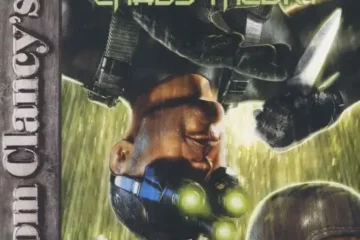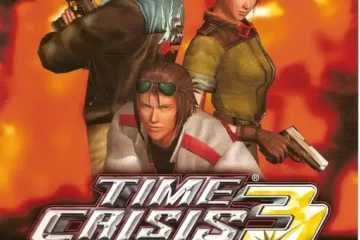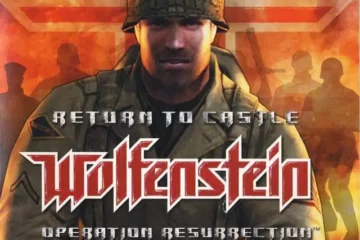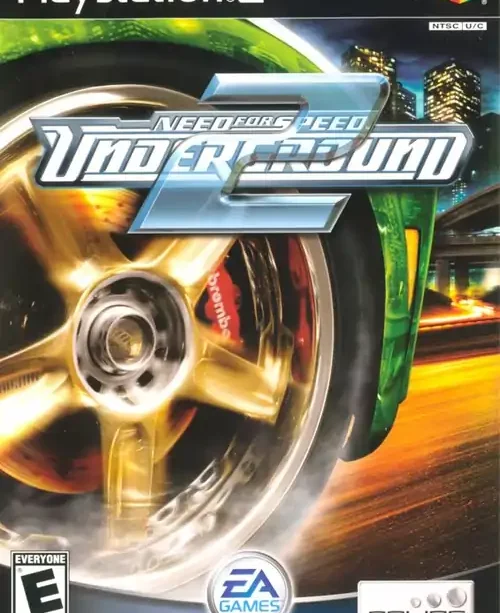
Need for Speed – Underground 2
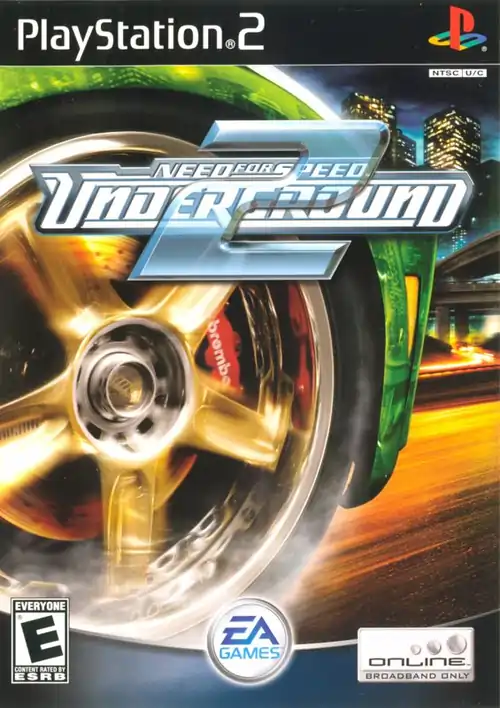
Console: PS2
Publisher: Electronic Arts
Genre: Racing
Region: EU, US
Released: NA: November 15, 2004 | EU: November 19, 2004 | AU: July 27, 2005
File size: 2.86GB
Dive into the adrenaline-fueled world of street racing with Need for Speed – Underground 2. Customize your ride and dominate the underground racing scene across three continents.
When Need for Speed Underground 2 hit PlayStation 2 in November 2004, it didn’t just transform racing games – it completely rewrote what we thought street racing could be. This wasn’t your typical point-to-point racer where you picked tracks from a menu. Instead, EA Black Box delivered something revolutionary: a sprawling open city called Bayview that was teeming with hidden shortcuts, night-time flair, and nonstop street action that made you feel like you were living the underground racing lifestyle.
Why NFS Underground 2 Redefined PS2 Racing Forever
Before Underground 2 came along, racing games were pretty formulaic. You’d get a car, pick a track from a menu, race for a few laps, then rinse and repeat. EA Black Box looked at that formula and said, “What if we just threw all that out the window?” The result was something that felt more like living in a street racing movie than playing a traditional racing game.
From the moment you fired up your turbocharged engine and heard that distinctive whine of a tuned import, you knew this was different. Bayview wasn’t just a collection of race tracks connected by roads – it was a massive urban playground where every street corner could lead to an impromptu race, every alley might hide a shortcut, and every parking garage could be your next drift paradise.
What made it special was how organic everything felt. Instead of selecting races from sterile menus, you’d cruise through the neon-lit streets until you spotted another racer. Flash your headlights, and suddenly you’re in an outrun race where the winner is whoever can get ahead by 1,000 feet first. It was the kind of spontaneous racing that made you feel like you were actually part of this underground scene rather than just playing a game about it.
Unparalleled Customization That Actually Mattered
Here’s where Underground 2 really showed its genius – personalizing your car wasn’t just about making it look cool (although you definitely could do that). Every modification you made actually affected your car’s performance in meaningful ways that changed how it handled on Bayview’s diverse street layouts.
Body Kits, Wraps, and Visual Wizardry
The visual customization system was absolutely mind-blowing for 2004. We’re talking about dozens of body kit options, spoilers, hoods, and side skirts that could transform a stock Honda Civic into something that looked like it belonged on the set of Fast and Furious. The vinyl system let you create custom graphics that made your ride unmistakable on Bayview’s streets – and trust me, you wanted to stand out when you were tearing through downtown at 3 AM.
But here’s what made it brilliant: the game actually tracked your “style” rating. The more unique and eye-catching your build, the more respect you’d earn from other racers. This wasn’t just cosmetic – higher style ratings opened up sponsor opportunities and magazine covers that provided real gameplay benefits.
Customization Categories:
- Visual Mods – Body kits, spoilers, hoods, side skirts, and bumpers
- Vinyl Graphics – Custom decals and wraps to make your ride unique
- Lighting – Neon underglow, headlights, and taillights
- Interior – Steering wheels, gauges, and roll cages
- Audio Systems – Subwoofers and speakers (with actual bass effects!)
Performance Upgrades That Changed Everything
The performance modification system was where Underground 2 really flexed its technical muscles. You could take a stock Honda Civic – basically a grocery-getter – and transform it into a street-eating monster that could hang with supercars. We’re talking about high-flow intake systems, turbochargers, race-tuned ECUs, and brake systems that actually changed how your car felt to drive.
Each upgrade wasn’t just a stat boost – it fundamentally altered your car’s character. Install a turbo, and you’d get that distinctive whistling sound along with power that hit like a freight train once the boost kicked in. Upgrade your suspension and tires, and suddenly you could take corners that would have sent your stock car sliding into the barriers.
Performance Upgrade Categories:
- Engine – Turbochargers, ECU, intake, and exhaust systems
- Transmission – Gear ratios and clutch upgrades for better acceleration
- Suspension – Lower ride height for better handling and cornering
- Tires & Wheels – Grip improvements and aesthetic wheel choices
- Brakes – Better stopping power for high-speed street racing
Bayview: The Ultimate Open Road Playground
Bayview wasn’t just big – it was intelligently designed. Every district had its own personality, its own challenges, and its own racing opportunities. This was one of the first racing games to truly nail the open-world concept, creating an environment that felt alive and reactive to your presence.
Downtown Bayview – Neon and Nightlife
The heart of Bayview was its downtown district, where neon lights reflected off wet asphalt and skyscrapers created urban canyons perfect for high-speed pursuits. This was drift paradise – tight corners between buildings that rewarded precise throttle control and perfect timing. The traffic patterns here were dense but predictable, creating opportunities for skilled drivers to thread the needle between cars at triple-digit speeds.
What made downtown special was how the architecture influenced racing lines. You’d learn to use building overhangs as reference points for braking zones, and the interplay of street lights and shadows created a visual rhythm that helped you anticipate upcoming corners even when racing at night.
Industrial Zone – Concrete and Steel
The industrial areas were where Underground 2 showcased its variety. Wide concrete expanses gave you room to stretch your car’s legs on high-speed runs, while the vertical ramps and elevation changes tested your car’s suspension setup and your ability to handle jumps without losing control on landing.
This was also where you’d find some of the most creative shortcuts – maintenance tunnels under factory complexes, loading dock ramps that could shave seconds off your time, and multi-level parking structures that became three-dimensional racing challenges.
Bayview Districts:
- Downtown Bayview – Neon-lit streets perfect for drift challenges and urban racing
- Industrial Zone – Wide concrete areas with vertical ramps and elevation changes
- Waterfront – Tight curves around docks ideal for high-speed slipstreaming
- Beacon Hill – Residential area with elevation changes testing braking and control
- Jackson Heights – Mixed commercial and residential racing opportunities
Thrilling Race Modes That Kept You Coming Back
Underground 2 didn’t just throw you into generic races and call it a day. Each race type demanded different skills, different car setups, and different strategies. This variety kept the gameplay fresh and encouraged you to experiment with different builds and driving styles.
Circuit and Sprint Racing
The bread and butter of Underground 2’s racing were the circuit and sprint events. Circuit races took you on multi-lap journeys through Bayview’s streets, where knowing the track layout became crucial for victory. Learning to draft behind opponents on long straights could mean the difference between first and fourth place.
Sprint races were pure point-to-point adrenaline rushes where route knowledge was everything. The shortest distance between two points might be a straight line, but in Bayview, the fastest route usually involved shortcuts through parking garages, industrial complexes, or residential areas that only local knowledge could reveal.
Drift Events – Style Over Speed
Drifting in Underground 2 was pure artistry. These events weren’t about crossing the finish line first – they were about earning style points by sliding through corners with perfect control. The longer and more controlled your drifts, the more points you’d accumulate. Perfect drifts would actually charge your nitrous gauge, creating a risk-reward system where spectacular driving was literally rewarded with more speed.
The drift tracks were masterfully designed, with elevation changes and banked corners that helped initiate slides while challenging you to maintain control through complex multi-corner sequences. Mastering drift events required completely different car setups focused on controllable oversteer rather than outright grip.
Drag Racing – Precision Under Pressure
Drag races were all about perfection – perfect launch timing, perfect gear shifts, and perfect nitrous deployment. These quarter-mile showdowns demanded cars built for straight-line speed, but winning came down to driver skill more than raw horsepower.
The manual transmission system really shone in drag events. You had to watch your tachometer like a hawk, shifting at exactly the right RPM to keep your engine in its power band. Shift too early and you’d lose power. Shift too late and you’d bounce off the rev limiter, costing precious time.
Expert Tips to Dominate Bayview’s Streets
After countless hours tearing through Bayview’s neon-lit streets, here are the strategies that separate the posers from the pros:
Building the Perfect Ride
Balance is everything. Don’t just max out horsepower and call it a day. A 400-horsepower monster that can’t turn corners will get destroyed by a well-balanced 300-horsepower car with proper suspension tuning. Start with handling upgrades, then add power gradually as you learn to control what you’ve built.
Nitrous strategy matters. Save your boost for long straightaways where you can maintain full throttle. Using nitrous mid-corner is usually a recipe for meeting the nearest wall up close and personal. Learn the tracks, identify the ideal nitrous zones, and be patient.
Pro Racing Tips:
- Shortcut Mastery – Explore every alley and ramp; hidden routes can shave seconds off lap times
- Traffic Reading – Learn NPC car patterns to predict gaps in downtown racing
- Car-Specific Builds – Different events favor different car types and setups
- Earning Fast Cash – Complete URL races and sponsor challenges for maximum payout
- Style Points – High visual ratings unlock better sponsor deals and magazine covers
Money-Making Strategies
Underground 2’s economy required smart financial planning. URL (Underground Racing League) events paid the best purses, but they also demanded well-tuned cars to compete effectively. Sponsor challenges were reliable money-makers that often had lower entry requirements.
Don’t ignore the magazine photo shoots and sponsor deals. These provided steady income streams that funded your next round of upgrades. Plus, seeing your custom ride on the cover of import tuner magazines never got old.
Frequently Asked Questions
How long is the main career mode?
Most players can expect 8-10 hours to complete Underground 2’s storyline and unlock most events. However, if you’re the completionist type who wants to try every car, unlock every customization part, and dominate every race type, you’re looking at closer to 20-25 hours of gameplay.
Can I drive anywhere in Bayview from the start?
Bayview is open from the beginning, and you can explore the entire city in free roam mode. However, tougher races in advanced districts require better-tuned cars to compete effectively. The game naturally guides your progression through increasingly challenging areas.
Are there any missable customization parts?
Some high-end performance parts and visual modifications only unlock in late-game events or by achieving specific sponsor requirements. The good news is you can always return to earlier areas to rerun challenges and unlock missed components.
Which car build is best for beginners?
Start with a well-balanced tuner like the Mazda RX-7 or Honda Civic Si. These cars are forgiving to drive and respond well to modifications. Focus on handling upgrades first (suspension, tires, brakes), then gradually add power as your driving skills improve.
Does Underground 2 support multiplayer on PS2?
Yes! The PS2 version supported both split-screen local multiplayer and online racing through the Network Adapter. While the online servers are no longer active, you can still enjoy head-to-head races with friends using split-screen mode.
The Legacy That Changed Racing Games Forever
Looking back twenty years later, it’s clear that Underground 2 didn’t just succeed – it fundamentally changed what players expected from racing games. The open-world concept that seemed revolutionary in 2004 became the gold standard for racing games that followed. From Need for Speed Most Wanted to modern titles like Forza Horizon, every open-world racer owes a debt to what EA Black Box accomplished with Bayview.
The customization depth that felt so comprehensive in 2004 set expectations that developers are still trying to meet. The idea that your visual modifications should matter beyond just looks – that style ratings could unlock gameplay opportunities – influenced how progression systems work in racing games today.
Cultural Impact Beyond Gaming
Underground 2 didn’t just change gaming – it influenced real-world car culture. The game arrived at the perfect time to capitalize on the import tuner scene’s explosion into mainstream popularity. Movies like The Fast and the Furious had introduced audiences to street racing culture, but Underground 2 let them actually participate in it.
The game’s soundtrack became legendary, featuring artists like Skindred, Capone, and The Doors alongside electronic tracks that perfectly captured the underground racing atmosphere. These songs are still associated with late-night street racing and car modification culture today.
Whether you experienced Underground 2 during its original PlayStation 2 run or discovered it through backward compatibility and emulation, the game remains essential racing. It proved that racing games could be more than just cars going fast in circles – they could be virtual lifestyles that let players express creativity, master challenging skills, and explore beautifully crafted worlds at their own pace.
In the pantheon of PlayStation 2’s greatest racing achievements, Need for Speed Underground 2 stands as the title that showed the world what open-world racing could become. Its influence echoes through every modern racing game that features customization, open exploration, and the freedom to approach challenges in your own unique style. More than just a racing game, it was an interactive celebration of car culture that proved video games could capture not just the mechanics of driving, but the passion and creativity that make car enthusiasts tick.
Related PlayStation 2 Racing Games:
- – Need for Speed Underground PS2 – Where It All Started
- – Need for Speed Most Wanted PS2 Police Chase Epic
- – Need for Speed Carbon PS2 Canyon Racing Adventure
- – Midnight Club 3: DUB Edition PS2 Street Racing
- – Burnout 3: Takedown PS2 Arcade Racing Mayhem
- – Gran Turismo 4 PS2 Simulation Racing Perfection
External Resources:
Tom Clancy’s Splinter Cell – Chaos Theory
October 24, 2025Time Crisis 3
October 24, 2025Return to Castle Wolfenstein: Operation Resurrection
October 24, 2025

